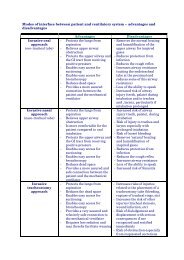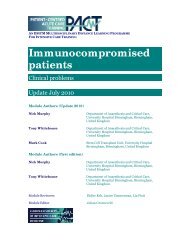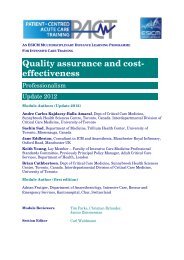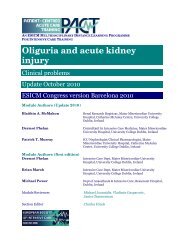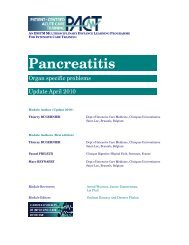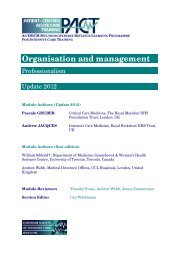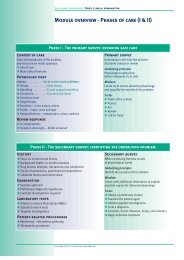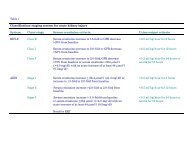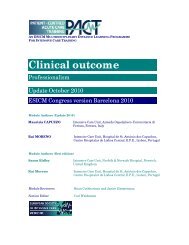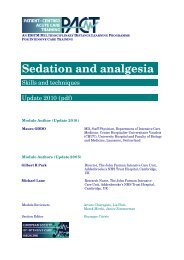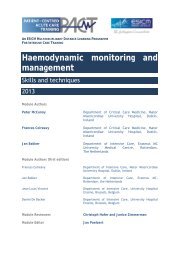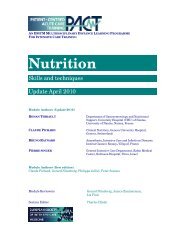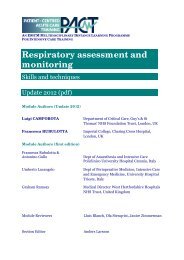Burns injury - PACT - ESICM
Burns injury - PACT - ESICM
Burns injury - PACT - ESICM
Create successful ePaper yourself
Turn your PDF publications into a flip-book with our unique Google optimized e-Paper software.
Non-nutritional modulation of metabolism<br />
Decreasing the loss of lean body mass requires a multimodal approach that includes<br />
nursing in a warm environment (28-32°C) particularly during surgery and in case of<br />
open wound therapy, early surgical debridement and grafting, appropriate analgesia<br />
and sedation, pharmacological attenuation of the hypermetabolic response, and<br />
stimulation of anabolism.<br />
Propranolol, by attenuating the sympathetic response and its non-selective metabolic<br />
beta-2 blocking actions, strongly reduces catabolism and reduces cardiac work load<br />
in children and adults. Anabolic agents, such as insulin and oxandrolone, accelerate<br />
wound healing and shorten hospital stay. Oxandrolone started within 7 days of <strong>injury</strong><br />
has been shown to improve long term outcome in both adults and children in<br />
prospective randomised trials. Recombinant growth hormone (GH) probably has its<br />
place in the treatment of children (but not in adult burns patients) as children with<br />
burn injuries have a proven GH deficit.<br />
Wolf SE, Edelman LS, Kemalyan N, Donison L, Cross J, Underwood M, et al.<br />
Effects of oxandrolone on outcome measures in the severely burned: a<br />
multicenter prospective randomized double-blind trial.J Burn Care Res<br />
2006;27(2): 131–139; discussion 140-141. PMID 16566555<br />
Patients with large burns are strongly catabolic, and weight loss is<br />
considerable; this response can be reduced by beta-blockade and liberal protein<br />
supply.<br />
Williams FN, Herndon DN, Kulp GA, Jeschke MG. Propranolol decreases cardiac<br />
work in a dose-dependent manner in severely burned children. Surgery<br />
2011; 149(2): 231–239. PMID 20598332<br />
Gauglitz GG, Williams FN, Herndon DN, Jeschke MG. <strong>Burns</strong>: where are we<br />
standing with propranolol, oxandrolone, recombinant human growth<br />
hormone, and the new incretin analogs? Curr Opin Clin Nutr Metab Care<br />
2011; 14(2): 176–181. PMID 21157309<br />
Jeschke MG, Finnerty CC, Kulp GA, Przkora R, Mlcak RP, Herndon DN.<br />
Combination of recombinant human growth hormone and propranolol<br />
decreases hypermetabolism and inflammation in severely burned<br />
children. Pediatr Crit Care Med 2008; 9(2): 209–216. PMID 18477935<br />
Porro LJ, Herndon DN, Rodriguez NA, Jennings K, Klein GL, Mlcak RP, et al.<br />
Five-year outcomes after oxandrolone administration in severely burned<br />
children: a randomized clinical trial of safety and efficacy. J Am Coll<br />
Surg 2012; 214(4): 489–502; discussion 502–504. PMID 22463890<br />
Pham TN, Klein MB, Gibran NS, Arnoldo BD, Gamelli RL, Silver GM, et al. Impact<br />
of oxandrolone treatment on acute outcomes after severe burn <strong>injury</strong>. J<br />
Burn Care Res 2008; 29(6): 902–906. PMID 18849836<br />
32



